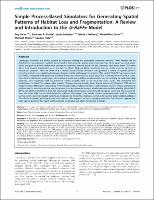| dc.creator | Pe'er, Guy | |
| dc.creator | Zurita, Gustavo Andrés | |
| dc.creator | Schober, Lucia | |
| dc.creator | Bellocq, Maria Isabel | |
| dc.creator | Strer, Maximilian | |
| dc.creator | Müller, Michael | |
| dc.creator | Pütz, Sandro | |
| dc.date.accessioned | 2023-08-23T02:08:31Z | |
| dc.date.available | 2023-08-23T02:08:31Z | |
| dc.date.issued | 2013-05-28 | |
| dc.identifier.citation | Pe'er, G., Zurita, G., Schober, L., Bellocq, M. I., Strer, M., Müller, M., Pütz, S. (2013). Simple Process-Based Simulators for Generating Spatial Patterns of Habitat Loss and Fragmentation: A Review and Introduction to the G-RaFFe Model. PLOS ONE; (5). | es_AR |
| dc.identifier.other | CCPI-FCF-A-090 | |
| dc.identifier.other | 25020 | |
| dc.identifier.uri | https://hdl.handle.net/20.500.12219/4997 | |
| dc.description | Fil: Pe'er, Guy. Helmholtz Centre for Environmental Research. Department of Conservation Biology; Germany. | es_AR |
| dc.description | Fil: Pe'er, Guy. Helmholtz Centre for Environmental Research. Department of Ecological Modelling; Germany. | en |
| dc.description | Fil: Zurita, Gustavo Andrés. Consejo Nacional de Investigaciones Científicas y Técnicas. Facultad de Ciencias Forestales. Instituto de Biología Subtropical; Argentina. | es_AR |
| dc.description | Fil: Zurita, Gustavo Andrés. Universidad Nacional de Misiones. Facultad de Ciencias Forestales. Instituto de Biología Subtropical; Argentina. | |
| dc.description | Fil: Schober, Lucia. University of Kassel. Center for Environmental Systems Research; Germany. | |
| dc.description | Fil: Schober, Lucia. Helmholtz Centre for Environmental Research. Department of Conservation Biology; Germany. | |
| dc.description | Fil: Schober, Lucia. Helmholtz Centre for Environmental Research. Department of Ecological Modelling; Germany. | |
| dc.description | Fil: Bellocq, Maria Isabel. Consejo Nacional de Investigaciones Científicas y Técnicas. Facultad de Ciencias Exactas y Naturales. Departamento de Ecología, Genética y Evolución; Argentina. | |
| dc.description | Fil: Bellocq, Maria Isabel. Universidad de Buenos Aires. Facultad de Ciencias Exactas y Naturales. Departamento de Ecología, Genética y Evolución; Argentina. | |
| dc.description | Fil: Strer, Maximilian. Helmholtz Centre for Environmental Research. Department of Conservation Biology; Germany. | en |
| dc.description | Fil: Strer, Maximilian. Helmholtz Centre for Environmental Research. Department of Ecological Modelling; Germany. | en |
| dc.description | Fil: Müller, Michael. Helmholtz Centre for Environmental Research. Department of Ecological Modelling; Germany. | en |
| dc.description | Fil: Pütz, Sandro. Helmholtz Centre for Environmental Research. Department of Conservation Biology; Germany. | en |
| dc.description | Fil: Pütz, Sandro. Helmholtz Centre for Environmental Research. Department of Ecological Modelling; Germany. | en |
| dc.description.abstract | Landscape simulators are widely applied in landscape ecology for generating landscape patterns. These models can be divided into two categories: pattern-based models that generate spatial patterns irrespective of the processes that shape them, and process-based models that attempt to generate patterns based on the processes that shape them. The latter often tend toward complexity in an attempt to obtain high predictive precision, but are rarely used for generic or theoretical purposes. Here we show that a simple process-based simulator can generate a variety of spatial patterns including realistic ones, typifying landscapes fragmented by anthropogenic activities. The model “G-RaFFe” generates roads and fields to reproduce the processes in which forests are converted into arable lands. For a selected level of habitat cover, three factors dominate its outcomes: the number of roads (accessibility), maximum field size (accounting for land ownership patterns), and maximum field disconnection (which enables field to be detached from roads). We compared the performance of G-RaFFe to three other models: Simmap (neutral model), Qrule (fractal-based) and Dinamica EGO (with 4 model versions differing in complexity). A PCA-based analysis indicated G-RaFFe and Dinamica version 4 (most complex) to perform best in matching realistic spatial patterns, but an alternative analysis which considers model variability identified G-RaFFe and Qrule as performing best. We also found model performance to be affected by habitat cover and the actual land-uses, the latter reflecting on land ownership patterns. We suggest that simple process-based generators such as G-RaFFe can be used to generate spatial patterns as templates for theoretical analyses, as well as for gaining better understanding of the relation between spatial processes and patterns. We suggest caution in applying neutral or fractal-based approaches, since spatial patterns that typify anthropogenic landscapes are often non-fractal in nature. | en |
| dc.format | application/pdf | |
| dc.format.extent | 7.925 MB | |
| dc.language.iso | eng | es_AR |
| dc.publisher | Simon Thrush, National Institute of Water & Atmospheric Research, New Zealand | en |
| dc.relation | info:eu-repo/semantics/altIdentifier/urn/https://journals.plos.org/plosone/article?id=10.1371/journal.pone.0064968 | |
| dc.rights | info:eu-repo/semantics/openAccess | |
| dc.rights.uri | | |
| dc.subject | Forests | en |
| dc.subject | Land use | en |
| dc.subject | Farms | en |
| dc.subject | Habitats | en |
| dc.subject | Trees | en |
| dc.subject | Principal component analysis | en |
| dc.subject | Roads | en |
| dc.subject | Regression analysis | en |
| dc.title | Simple Process-Based Simulators for Generating Spatial Patterns of Habitat Loss and Fragmentation: A Review and Introduction to the G-RaFFe Model | en |
| dc.type | info:eu-repo/semantics/article | |
| dc.type | info:ar-repo/semantics/artículo | |
| dc.type | info:eu-repo/semantics/publishedVersion | |



